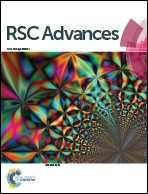Fracture toughness and failure mechanisms in un-vulcanized and dynamically vulcanized PP/EPDM/MWCNT blend-nanocomposites†
Abstract
The fracture toughness and deformation mechanisms of un-vulcanized and dynamically vulcanized polypropylene/ethylene–propylene–diene terpolymer (PP/EPDM) blends and polypropylene/ethylene–propylene–diene terpolymer/multi walled carbon nanotube (PP/EPDM/MWCNT) blend-nanocomposites were investigated using the essential work of fracture (EWF) methodology followed by detailed microscopy analysis. The effect of maleic anhydride grafted polypropylene (PP-g-MA) on the morphology and fracture toughness of the multicomponent system was also investigated. It was found that both the dynamic vulcanization and compatibilization using PP-g-MA increased the fracture toughness of the blend and blend-nanocomposite systems. The results illustrated that the dominant fracture mechanism related to the EPDM dispersed phase in un-vulcanized samples was the formation of dilatation bands due to cavitation and/or debonding of dispersed EPDM rubber particles. In vulcanized samples, the development of dilatation shear bands, resulting from repeated particle debonding, was suppressed and the formation of nanovoids and cavitation in rubber particles led to promoting shear yielding of the adjacent matrix and dense plastic deformation. Incorporation of MWCNTs into the PP/EPDM blend reduced the essential work of fracture (we) and enhanced the non-essential work of fracture (βwp). In the blend-nanocomposites, two mechanisms induced by the MWCNTs were observed. While large MWCNT aggregates acted as favored sites for crack initiation, the individual MWCNT impregnated fibrils arrested the crack propagation. The presence of PP-g-MA diminished the negative effect of MWCNTs and further enhanced their positive effect through decreasing the size of large aggregates (favored sites to initiate large cracks) and increasing the number of dispersed individual MWCNT ropes (increasing the potential of impregnated fibril formation), respectively.


 Please wait while we load your content...
Please wait while we load your content...